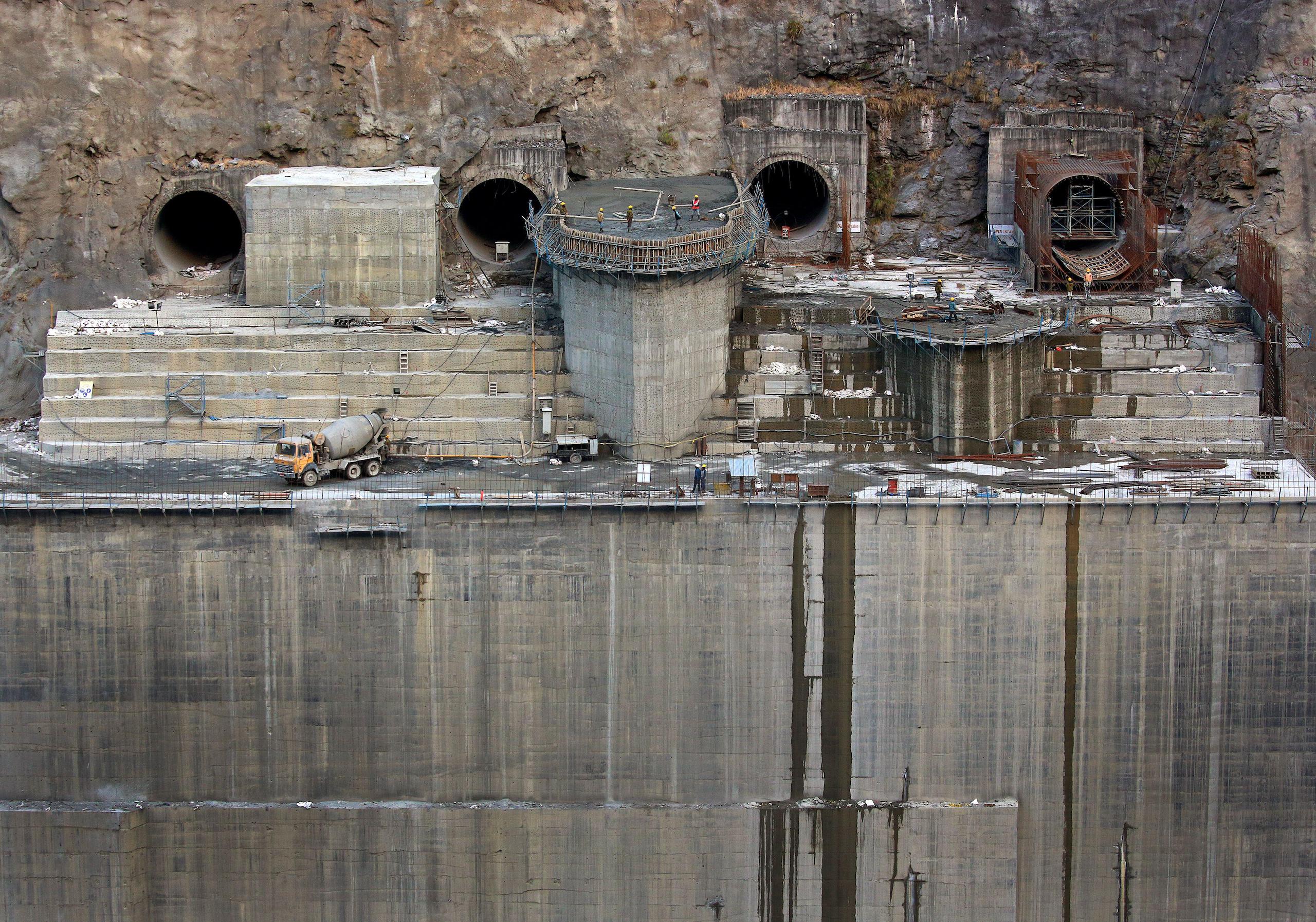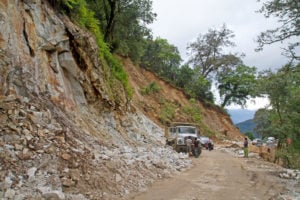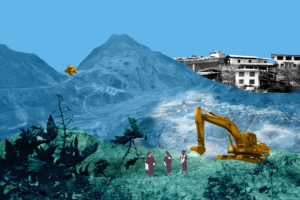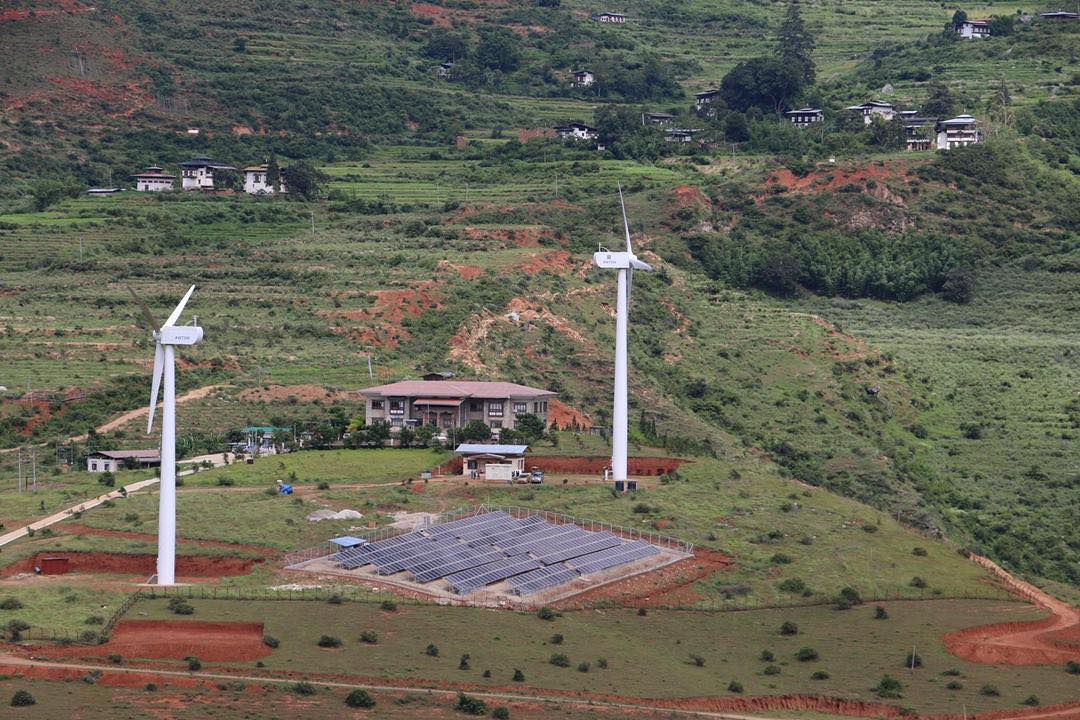 Construction work in December 2017 on one of the Punatsangchhu hydroelectric power projects. The two plants, the largest to be built in Bhutan, were meant to be completed by 2020, but have been significantly delayed, costing more than a billion dollars. (Image: Hazel McAllister / Alamy)" />
Construction work in December 2017 on one of the Punatsangchhu hydroelectric power projects. The two plants, the largest to be built in Bhutan, were meant to be completed by 2020, but have been significantly delayed, costing more than a billion dollars. (Image: Hazel McAllister / Alamy)" />Construction work in December 2017 on one of the Punatsangchhu hydroelectric power projects. The two plants, the largest to be built in Bhutan, were meant to be completed by 2020, but have been significantly delayed, costing more than a billion dollars. (Image: Hazel McAllister / Alamy)
Fifteen years ago, Bhutan announced that by 2020 it would be able to produce an additional 10,000 megawatts of electricity from hydropower. So far, the country is able to generate less than a quarter of this target: total installed capacity is 2,326 MW, up from 1,480 MW in 2008.
Of the four hydropower plants under the 10,000 MW scheme, only one, Mangdechhu, has been completed and is operational. The other three are running years behind schedule and will cost more than a billion US dollars more than originally expected, with only one expected to start operating in the foreseeable future.
The issue of delays and cost overruns around the scheme was raised in June last year in the National Council – the upper house of the Bhutanese parliament – which stated that there is growing concern around this. With hydropower contributing 14% of GDP and 26% of government revenues, the sector is an important pillar of economic growth, pointed out Kalyani Honrao, research analyst at the Economist Intelligence Unit.
The story of why the country has failed to achieve the 10,000 MW target is one of a complex combination of geological, administrative and financial problems. As the evidence mounts that the impacts of climate change necessitate a rethink of dam project design, Bhutan remains wedded to hydropower, generating nearly all of its electricity in this way. This is partially because of the renewable energy ambitions of the main buyer of its surplus electricity, India.
| Project | Installed capacity (MW) | Project status |
| Punatsangchhu I | 1,200 | Under construction |
| Punatsangchhu II | 1,020 | Under construction, due to be commissioned in 2024 |
| Mangdechhu | 720 | Commissioned in 2019 |
| Kholongchhu | 600 | Under construction |
‘Poor geological conditions’ delay projects
Loknath Sharma, Bhutan’s minister for energy and natural resources, told The Third Pole that in 2008 India and Bhutan committed to jointly pursue the 10,000 MW-by-2020 goal as it was mutually beneficial, and would build on historical links and relations. India committed to provide assistance and funding, and to purchase Bhutan’s surplus electricity after 2020.
Chhewang Rinzin, managing director at Druk Green Power Corporation (DGPC), the government-owned utility company in charge of Bhutan’s hydropower sector, said: “The 1,200 MW Punatsangchhu I and 1,020 MW Punatsangchhu II projects… are substantially delayed after encountering poor geological conditions.”
When complete, the two Punatsangchhu projects will be the biggest in terms of installed capacity in Bhutan. The Punatsangchhu II project is nearly finished, and is supposed to start operating in October 2024 – almost seven years late. The Punatsangchhu I project was supposed to be completed in 2016 but has been plagued by accidents as a result of slope destabilisation. Most of the work has been completed, but it has no indicated commissioning date.
Sharma said: “Development of hydropower is not only a capital-intensive undertaking but has a long gestation period. It is even more challenging to construct hydropower in a Himalayan region with a very young and fragile geology.” These “complex adverse geological challenges have delayed projects in the country, leading to time and cost overruns,” he added.
There are concerns about this within wider civil society. Yeshi Dorji, an environmentalist and prominent blogger, said: “We have been misled all along in relation to our hydropower projects. The locations of the projects are wrong – they are too far away from the market; the prefeasibility study and geological investigation was shoddy and amateurish.”
Sharma told The Third Pole that India and Bhutan are working to finish the ongoing projects in a timely manner.
Large hydropower plants in Bhutan
| Hydropower plants | Installed capacity (MW) | Date commissioned |
| Basochhu Upper Stage | 24 | 2001 |
| Basochhu Lower Stage | 40 | 2004 |
| Kurichhu | 60 | 2002 |
| Chhukha | 336 | 1998 |
| Tala | 1,020 | 2007 |
| Dagachhu | 126 | 2015 |
| Mangdechhu | 720 | 2019 |
| Total | 2,326 |
Layers of bureaucracy
Administrative factors have also delayed the projects. Prior to the 10,000 MW-by-2020 initiative, hydropower plants supported by India were implemented as intergovernmental projects. India would provide funding in the form of grants and loans, and Bhutan would commission the projects. Under the scheme agreed in 2008, this changed to intergovernmental joint ventures. The first project to be undertaken as an intergovernmental joint venture was to be the 600 MW Kholongchhu project, which involved public sector hydropower companies from the two countries – Satluj Jal Vidyut Nigam (SJVN) from India and Bhutan’s DGPC. It was financed by Indian state-owned companies.
The expectation was that such projects would move faster, with the corporate entities being quicker to act. Instead, since both corporate entities were public sector undertakings, any differences in interpreting the joint venture arrangement had to be referred to the two governments. Major differences between shareholders and a 50:50 split in voting reportedly led to gridlock, with the joint venture deal for Kholongchhu only being signed in 2020. In February, it was announced that DGPC alone will complete the Kholongchhu project, and that SJVN would transfer its stake in the joint venture company to DGPC.
Sharma told The Third Pole: “With the changing energy landscape and evolving power market in the region, [the] two sides are revisiting the joint venture mode of implementation as it has not worked in the interest of the two countries.”
Cost of hydropower projects escalates
The June 2022 National Council discussion brought to the fore the fact that the Punatsangchhu I project was supposed to cost 35.15 billion Bhutanese ngultrum (USD 425 million), and now has cost BTN 93.76 billion (USD 1.13 billion) and is still not online. The Kholongchhu project was originally to cost BTN 33.05 billion (USD 400 million), which has run to BTN 54.82 billion (USD 660 million) and is far from complete.
BTN 93.76 billion
Amount spent on Punatsangchhu I so far, which is still not online
Punatsangchhu I was funded with a 40% grant and 60% loan from India; Punatsangchhu II 30% grant and 70% loan. The annual interest rate on the loans is 10%. As of the end of December 2022, hydropower debt accounted for nearly 70% of Bhutan’s external debt and over 80% of GDP, with long delays and cost overruns adding to pressure on the country’s financial stability. Yeshey Dorji, the environmentalist, expressed anger to The Third Pole at the cost of the loans, especially as they have increased with delays.
However, the pricing of the power bought by India means that Bhutan generates a 15% net return above the costs of the dams it has built with Indian financing. This is guaranteed in the cost structure of the four 10,000 MW-by-2020 projects. External commentators, including the World Bank, therefore have said they consider the debt to be “sustainable”.
The DGPC’s Rinzin said that despite the cost overruns, the per-megawatt installed capacity cost of projects has remained below or at least competitive in the region and beyond.
Climate change is another factor that could push costs up further, as it may necessitate design changes. Rinzin said that Bhutan is exploring more climate-resilient and sustainable hydropower schemes such as pumped storage and seasonal storage, which requires more engineering work and is much more expensive. In India’s latest budget in February 2023, finance minister Nirmala Sitharaman said the country will look into pumped storage hydropower.
The first Bhutanese hydropower project with a reservoir will be the 2,585 MW Sankosh project. Originally conceived of more than 30 years ago and still at the planning stage, Sankosh has been mired in controversy for years.
“There is renewed interest at the two governments’ level to take forward the Sankosh project. The DPR [detailed project report] for the 2,640 MW Kuri-Gongri has also been finalised,” said Rinzin. The Kuri-Gongri project, initially planned as a run-of-the-river project, is now envisaged as a reservoir-based dam. While the Sankosh and Kuri-Gongri projects have been under discussion and investigations carried out, no agreement has yet been signed to build them.
“On creating water reservoirs for pumped hydropower, while there is always a concern due to the younger more fragile Himalayas when compared to Europe, the reservoir sizes for pumped storage could be much smaller [for] the planned Sankosh and Kuri Gongri projects,” Rinzin added.
Hydropower delays mean Bhutan has to import electricity
Back in 2008, Bhutan expected to use the electricity from its hydropower plants to power its own growth and export the rest. With few plants coming online, it is now a net importer of electricity from India.
Before 2021, imported electricity from India to Bhutan was minimal, and balanced out by exports.
Since then, however, there has been a boom in energy-intensive industries being established as Bhutan establishes a new dry port in the town of Pasakha, as well as expanding the Jigmeling and Motanga industrial parks along the India-Bhutan border. This has pushed up the country’s total electricity demand, which it struggles to meet domestically during the winter months, when water flow is low and Bhutan’s run-of-the-river dams can only guarantee 415 MW out of their total 2,336 MW installed capacity, according to the DGPC. Between January and March 2022, the country had to buy power from the Indian Energy Exchange (IEX).
So far, Bhutan has been able to buy power relatively cheaply. While the market clearing price (MCP) at the IEX touched 14 Indian rupees (USD 0.17) per kWh during the period of import to Bhutan, the country managed keep the price under INR 3.32 (USD 0.04) per kWh by importing during the off-peak hours.
Chhewang Rinzin warned that “Bhutan will be importing power again from January to April and during December 2023. The MCPs are expected to be much higher and the question of affordability by Bhutan consumers of imported power will likely become an issue.”
He also said for facilitating imports, the whole of Bhutan’s power system will also come under the India’s Deviation Settlement Mechanism regulations, and if Bhutan can’t anticipate and manage demand for power, huge liabilities could arise from the provisions for penalties.
What is the Deviation Settlement Mechanism?
The reliability and stability of electricity grids depends on matching demand with supply. Therefore, there are regulations to ensure that there are no deviations in committed supply from generators and committed demand from consumers. Any deviation in the committed supply and demand would have a destabilising impact on the grid, which sometimes leads to grid failure.
So that generators and consumers stay within their commitments, India has put in place the Deviation Settlement Mechanism (DSM) regulations that penalise those who fail to comply.
For imported electricity, Bhutan is also now required to comply with these regulations. Failure to comply could incur penalties running to millions of ngultrum under the DSM.
Nepal also has to comply with the DSM.
“For a small country like Bhutan, the import tariffs and deviation penalties could prove to be huge financial burden,” Rinzin said.
Minister Loknath Sharma said: “With completion of ongoing projects coupled with development of utility-scale solar projects, we will endeavour to remain net surplus all-round the year. We are actively pursuing development of a few reservoirs and pump storage as well. The power trade between Bhutan and India will only grow by leveraging the diversity of energy demand and resource endowments.”
Calls to diversify away from hydropower
During a conference on 13 October 2022, Dechen Dema, executive engineer at the Department of Renewable Energy, which falls within Bhutan’s Ministry of Energy and Natural Resources, said that depending solely on one source of energy can lead to future scarcity.
Sharma told The Third Pole that there is a need to integrate hydropower with renewable energy technologies. Bhutan’s Sustainable Hydropower Development Policy, 2020 for example, emphasises developing green hydrogen alongside hydropower. It also recommends keeping one or two river systems dam-free until and unless existing projects are no longer profitable.
The EIU’s Honrao said that given the impacts of climate change make Bhutan’s power sector vulnerable to seasonal fluctuations in hydropower generation, the government should take steps to diversify the energy mix.
The Third Pole reached out to the Indian ambassador in Bhutan about the issues raised in this story but had not received a response at the time of publication











0 Comments
LEAVE A COMMENT
Your email address will not be published